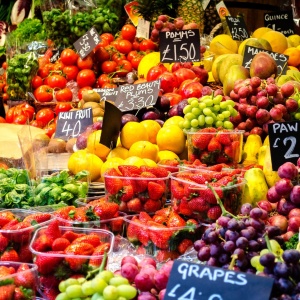
The global agricultural system doesn’t produce enough fruit, vegetables and protein to meet the nutritional needs of the world’s population, according to this paper. Meanwhile, grains, fats and sugars are overproduced, relative to what is needed for a healthy diet (defined in this paper as a diet in accordance with the Harvard Healthy Eating Plate (HHEP)).
The figure below shows actual production data and the amount needed for everyone to follow the HHEP recommended diet.

Image: Figure 1, Bahadur KC et al. Serving sizes were calculated with reference to the Canadian Food Guide and the US Department of Agriculture.
According to the paper, a global shift to the HHEP diet would require 51 million fewer hectares of arable land than currently used. The area of land used for grain, sugar, fat and oil production would fall, while the area of land used for fruit and vegetables, livestock feed and plant protein would increase.
The amount of pastureland required for the HHEP diet would be 458 million hectares greater than the current area of pastureland. The authors state, “This underlines the need for greater reliance on other protein sources”. They point out that consumption of animal products can help to combat malnutrition in some poorer areas of the world, saying “meat consumption will continue, but cannot persist at today’s levels without major consequences”.
Abstract
Sustainably feeding the next generation is often described as one of the most pressing “grand challenges” facing the 21st century. Generally, scholars propose addressing this problem by increasing agricultural production, investing in technology to boost yields, changing diets, or reducing food waste. In this paper, we explore whether global food production is nutritionally balanced by comparing the diet that nutritionists recommend versus global agricultural production statistics. Results show that the global agricultural system currently overproduces grains, fats, and sugars while production of fruits and vegetables and protein is not sufficient to meet the nutritional needs of the current population. Correcting this imbalance could reduce the amount of arable land used by agriculture by 51 million ha globally but would increase total land used for agriculture by 407 million ha and increase greenhouse gas emissions. For a growing population, our calculations suggest that the only way to eat a nutritionally balanced diet, save land and reduce greenhouse gas emissions is to consume and produce more fruits and vegetables as well as transition to diets higher in plant-based protein. Such a move will help protect habitats and help meet the Sustainable Development Goals.
Reference
Bahadur KC, K., Dias, G. M., Veeramani, A., J. Swanton, C. J., Fraser, D., Steinke, D., Lee, E., Wittman, H., Farber, J. M., Dunfield, K., McCann, K., Anand, M., Campbell, M., Rooney, N., Raine, N. E., Van Acker, R., Hanner, R., Pascoal, S., Sharif, S., Benton, T. G. and Fraser, E. D. G., 2018. When too much isn’t enough: Does current food production meet global nutritional needs? PLoS ONE 13(10): e0205683.
Read the full paper here. See also the Foodsource resource How might we define sustainable and healthy eating patterns (SHEPs)?












Post a new comment »